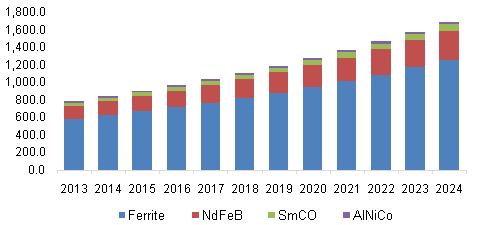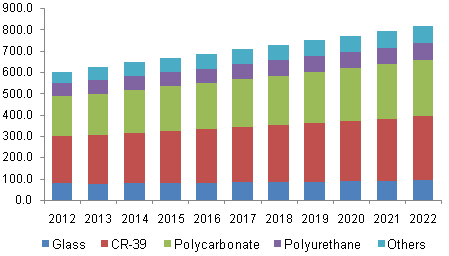The global market for permanent magnets is expected to reach USD 31.18 billion by 2020, according to a new study by Grand View Research, Inc. Growth of global automobile industry is expected to be a key driving factor for permanent magnets market over the forecast period. Permanent magnets are widely used for numerous applications in automobile industry. Various components such as motors, alternators and gearbox require permanent magnets for their mechanism. Grand View Research further observes that the shift in trend towards developing renewable energy generation including solar and wind energy is also expected to drive the market for permanent magnets. Permanent magnets are used in the stator of the wind turbine which is responsible for producing AC electricity.
Ferrite magnets dominated the global market, accounting for over 80% of total volumes in 2012. However, in terms of revenue, ferrite magnets accounted for just over 20% of the total revenue for the same year. Ferrite magnets are relatively cheaper than other permanent magnets such as NdFeB magnets, SmCO and Alnico magnets and hence account for a relatively smaller revenue share in the overall market. NdFeB is expected to be the fastest growing product segment, at an estimated CAGR of 9.4% from 2013 to 2020. Growing awareness regarding the benefits offered by NdFeB over other magnets in high performance automotive applications is expected to drive its demand over the forecast period.
View
summary of this report @ http://www.grandviewresearch.com/industry-analysis/permanent-magnets-industry
Global permanent magnets volume share, by product, 2012
Further Key findings from the study
suggest:
- Global permanent magnets demand is expected to reach 1,262.6 kilo tons by 2020 growing at a CAGR of 8.6% from 2013 to 2020
- Automotive industry emerged as the leading application market for permanent magnets and accounted for approximately half of the total consumption in 2012. However, the shift in trend towards adoption of renewable energy including wind energy has helped energy generation to become the most attractive market for permanent magnets. Energy generation is expected to be the fastest growing application market for permanent market at an estimated CAGR of 9% from 2013 to 2020
- Asia Pacific dominated the overall market for permanent magnets and accounted for 80% of the total consumption in 2012. China alone accounted for 65% of world’s demand for permanent magnets in 2012, consolidating its position as the leading permanent magnets producer as well as consumer, on account of huge rare earth metals deposits in the country which are available at an affordable price for domestic industries
- China is expected to continue its dominance in the global market with its government announcing plans to increase permanent magnets capacity in the nation by 20 kilo tons by 2015
- The global market for permanent magnets is highly fragmented with a large number of small Chinese manufacturers operating in the market. These small manufacturers pose threat to large manufacturers in terms of their price offerings. Some of the major companies operating in the global market for permanent magnets include Adams Magnetic Products Co., Hangzhou Permanent Magnet Group, Anhui Earth-Panda Advance Magnetic Material Co. Ltd and Hitachi Metals Ltd., Molycorp Magnequench and Shin-Etsu Chemical Co. Ltd among some other companies
Browse All Reports of
this category @ http://www.grandviewresearch.com/industry/automotive-and-aerospace-interior-materials
For the purpose of this study, Grand
View Research has segmented the global permanent magnets market on the basis of
product, application and region:
Permanent Magnets Product Outlook,
- Ferrite
- Neo (NdFeB)
- SmCO
- Alnico
Permanent Magnets Application
Outlook,
- Automotive
- Electronics
- Energy Generation
- Other
Permanent Magnets Regional Outlook,
- North America
- Europe
- China
- Rest of Asia Pacific
- Rest of the World


